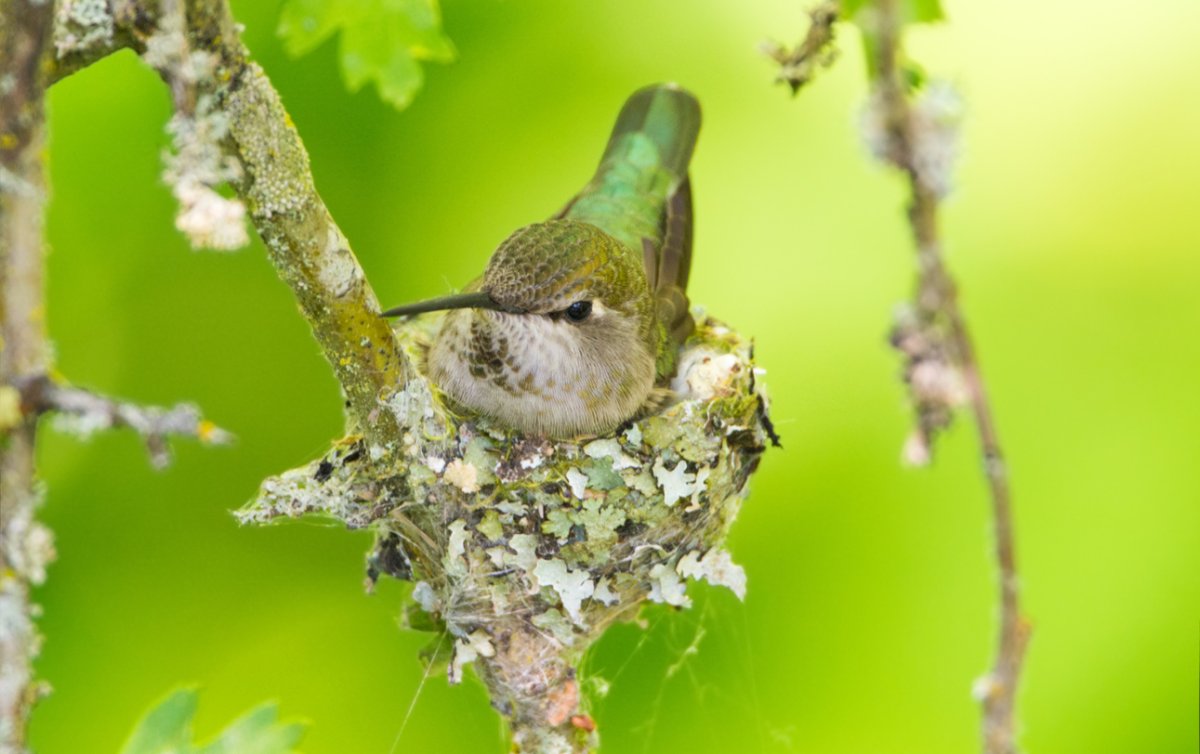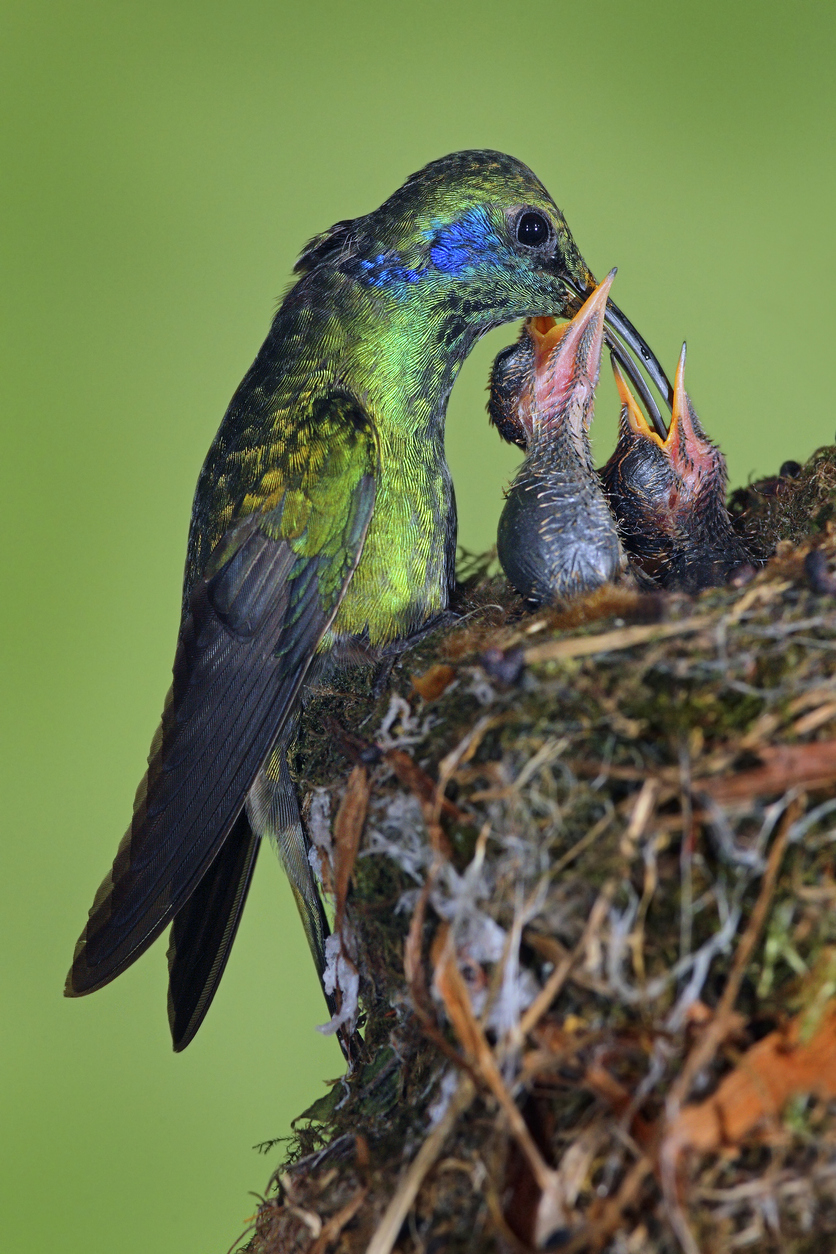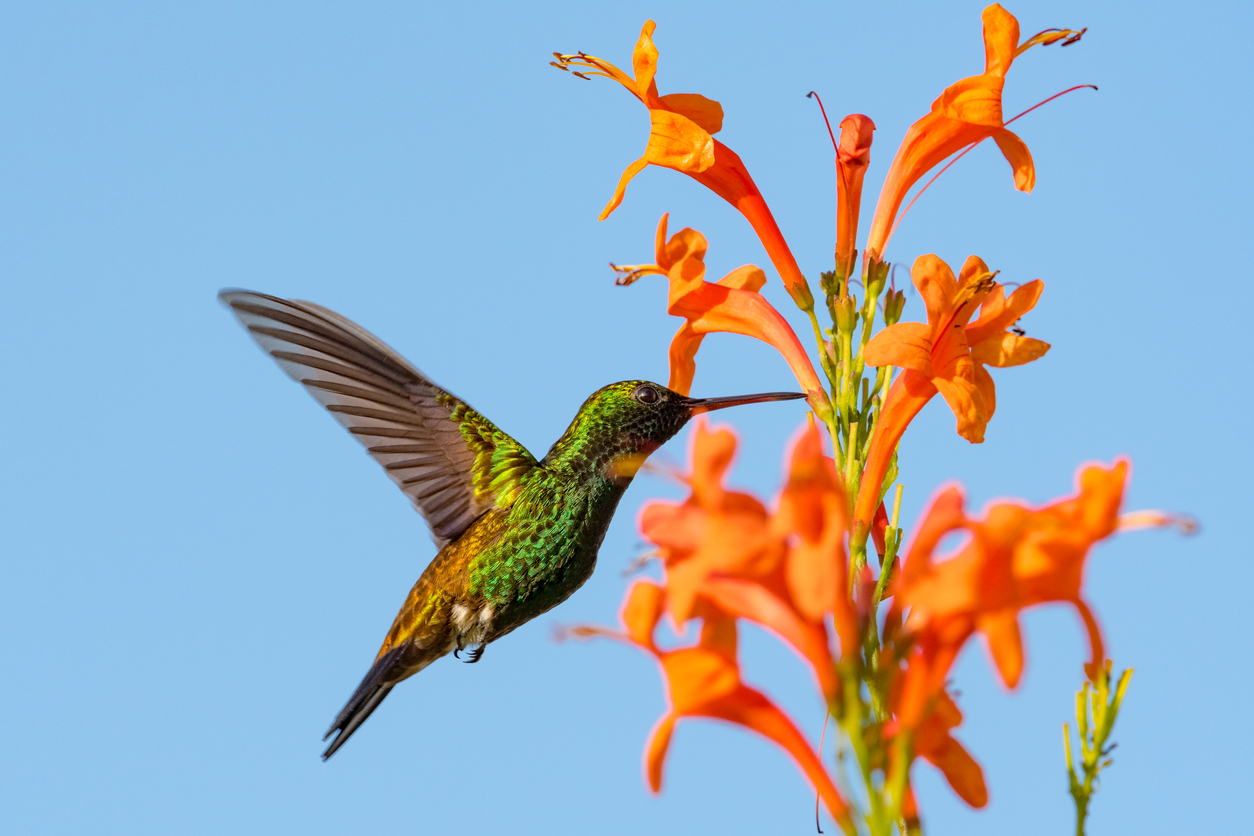

We may earn revenue from the products available on this page and participate in affiliate programs. Learn More ›
While every bird’s nest is proof of nature’s amazing artistry, there’s something almost magical about hummingbird nests. These tiny birds are found only in the Americas, although the vast majority of the 330 or so species never venture farther north than Central and South America. Around two dozen species of hummingbirds migrate to North America, typically arriving in early spring and remaining until they migrate south again in the early fall. Common species seen in North America include Anna’s, Costa’s, Allen’s, ruby-throated, rufous, and black-chinned hummingbirds. Of these, only the ruby-throated hummingbird routinely migrates to the eastern half of the United States; the other species are found only on the West Coast, particularly in Southern California and Arizona.
If you live in an area that is populated by hummingbirds during their breeding season, which is generally mid-spring through summer, you might be lucky enough to spot a hummingbird tending to her eggs or chicks. Here’s what to know about amazing, tiny hummingbird nests.

1. Nests can be built in unexpected locations.
While the particulars vary by hummingbird species, as a general rule, female hummingbirds build their nests in trees or thick shrubbery, which provide the mother and her young protection from predators and the elements. You’ll usually find hummingbird nests 5 to 10 feet or more off the ground—even as high as 90 feet above the ground—perched in the fork of small tree or bush branches.
It’s not that unusual, however, for a mother hummingbird to choose a seemingly unwise spot for her tiny nest. Odd spots occasionally chosen by hummers for nest building include:
- The chain of a hanging flower basket—or inside the basket
- On top of a strand of string lights, clothesline, or wire
- On a porch light or outdoor security camera
- Atop an outdoor lighting fixture, fire sprinkler, or small pipe
- In a tennis net, basketball net, or trampoline safety net
- On a backyard statue, fountain, or other yard decoration
One place you won’t find a hummingbird nest, however, is inside a nesting box. Unlike many other species of backyard birds, hummers shun human-provided nesting spots.
Should you be lucky enough to spot a tiny nest in a tree, shrub, or other spot in your garden, it’s important to resist the urge to sneak up close or touch the nest. As with most birds, the mother hummer could be spooked enough by your proximity to abandon her nest, possibly even her babies. Stick with binoculars or the zoom on your camera to grab those close-up views.
RELATED: 7 Important Things to Know About Your Hummingbird Feeder

2. Hummingbird nests are incredibly small.
Some birds build enormous nests. A bald eagle’s nest can be 5 feet wide and 4 feet deep and, because these birds build on to existing nests each year, some nests eventually reach 10 feet across. By contrast, the typical hummingbird nest is a mere 1.5 inches in diameter, roughly the size of a ping-pong ball.
While hummingbirds’ nest-building endeavors vary somewhat by species, most build a cup-shaped nest that’s tightly woven and slightly stretchy to keep the hatchlings safe and secure. Not every bird takes such care to provide a safe haven for their young: Mourning doves, for example, tend to build flimsy nests of pine needles, twigs, and grass that are so loosely woven that it’s not uncommon for eggs or fledglings to fall right through.
3. They use some surprising materials.
Every species of bird has its preferred nest-building materials, and hummers are no exception. As you might expect, the larger the bird, the larger and heavier the nest materials it can carry. Small birds like hummers tend to stick with lightweight materials.
A hummingbird nest is a soft and cozy haven for eggs and hatchlings, unlike the nests of many other birds that build rather hard structures of woven twigs. To achieve the desired coziness, along with the necessary strength and stretch of the finished nest, female hummers look for materials they can easily carry back to their nesting site and then tightly weave together. Common materials you might find in hummingbirds’ nests include:
- Tiny bits of bark
- Leaves, especially those with a fuzzy coating
- Fluff from seed pods
- Moss and lichens
- Feathery-textured ornamental grasses
- Cotton fiber
- Feathers
- Spider webs
4. Females do all the work.
Some species of birds, including bald eagles, whooping cranes, and California condors, mate for life. The male and female remain together year after year to breed and cooperatively raise their young. Most avian species, however, form a monogamous pair that stays together only long enough to raise one brood of young, or only for one full nesting season. (Many types of birds lay eggs and raise young two or more times each breeding season.)
And then there’s the hummingbird. Male hummers have a “love ’em and leave ’em” philosophy: The male courts the female with a spectacular flight pattern of full-speed dives and dashes, but after mating, has nothing further to do with nest building, egg laying and incubation, or care of the hatchlings. The female hummingbird is on her own. It’s common, too, for a male hummingbird to mate with several females during the breeding season.
RELATED: 30 Gorgeous Plants That Attract Hummingbirds to Your Garden
5. The babies don’t stick around for long.
Most bird species don’t spend a lot of time with their parents, and the hummingbird is no exception. After mating, the female spends a few days building her nest and then lays two tiny eggs, each around the size of a jellybean. She then spends the next couple of weeks sitting on the eggs to keep them warm and protected, only leaving for a few minutes each hour to eat.

Once hatched, the female must provide food—a mixture of nectar, tiny insects, and pollen—for her young, which she regurgitates into their mouths. She can’t spend too much time away from the nest searching for food, however. For the first several days of life, hummingbird hatchlings cannot regulate their own body temperatures, and so depend on their mother to keep them warm.
Baby hummers start to develop their first real feathers by the end of their first week, and after three weeks or so are ready to leave the nest to start life on their own. Depending on the species of hummingbird, the weather, and the time of year, the female might then produce a second clutch of eggs within the same breeding season.
6. There are ways to tempt hummingbirds to nest in your yard.
Although hummingbird nests are so small and well camouflaged that it’s difficult to spot them, there are things you can do to increase the chances of hummingbirds visiting—and nesting in— your garden. First, you’ll need to provide plenty of their favorite food, which is sugary nectar. Hanging a hummingbird feeder filled with a solution of one-part white table sugar to four parts water encourages hummingbird visitors. Situate the feeder in an open area that’s easily spotted from above, but close enough to a tree or shrub that the bird can use the greenery for protection.

Another way to bring hummers to your garden is by growing their preferred flowers. While many brightly colored, tubular-shaped flowers will do, some varieties that hummingbirds can’t resist include flowering tobacco, cardinal flower, bee balm, fuchsia, and honeysuckle.
